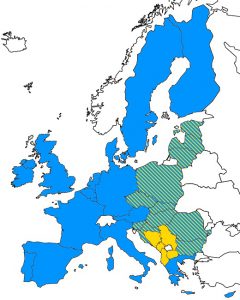 Chinese Premier Li Keqiang traveled to Budapest on November 27, 2017 to attend the 6th China- Central and Eastern European Countries summit.
Chinese Premier Li Keqiang traveled to Budapest on November 27, 2017 to attend the 6th China- Central and Eastern European Countries summit.
This meeting took place within the framework of the 16 + 1 cooperation which brings together sixteen countries of Central and Eastern Europe (including 11 members of the European Union) plus China. Launched in 2012, this initiative aims to foster relations between China and this part of Europe.
Today, Central Eastern Europe is considered by Beijing as a key region of the Belt and Road Initiative. Although Chinese investments are still limited, Beijing has many projects in the pipeline. After finding an agreement with Hungary and Serbia for the construction of a high-speed railway line between Budapest and Belgrade, Beijing and the countries of Central and Eastern Europe want to strengthen their cooperation.
At this meeting, the China-CEEC Inter-Bank Association was inaugurated, for which the Chinese Development Bank is expected to fund 2 billion euros for developping projects, especially transport infrastructures. For example, heads of state discussed the modernization of a railway line that would connect the port of Athens where the Chinese company COSCO has heavily invested to Vienna, the gateway to Western Europe.
Furthermore, Slovenia, Estonia and Lithuania have agreed to officially join the “Belt and Road” initiative; one of the objectives pursued by these countries is to better connect the Baltic Sea with the Mediterranean.
Premier Li Keqiang also encouraged companies in Central and Eastern Europe to increase their business with China.
Limits to 16 + 1 initiative

However, we can question the format of the 16 + 1 initiative. What do these countries have in common except their geographical position and the experience of a communist regime? What do Slovenia, a member of the euro zone and Albania share? The differences in terms of wealth and governance remain very important between the member states of the European Union and those that have not yet joined.
It is also important to remember that many investment and infrastructure decisions are made in coordination with all member states of the European Union. Division between Western Europe and Central Europe no longer seems relevant.
Nevertheless, it is true that Central and Eastern Europe must be more attractive towards foreign investors and Chinese in particular. It is now up to the European Union to reinforce the infrastructures of this region and develop a real policy of cooperation with China, particularly with regard to the “Belt and Road” initiative. It is not a question of being afraid of Chinese policy in Central and Eastern Europe, but of accompanying and coordinating “Belt and Road” projets with European policies to maximize its results.
Share the post "6th China Central and Eastern Europe Countries Summit"
